How to make Rosemary Olive Sourdough Bread with whole roasted garlic that requires no kneading and rises overnight. Video.
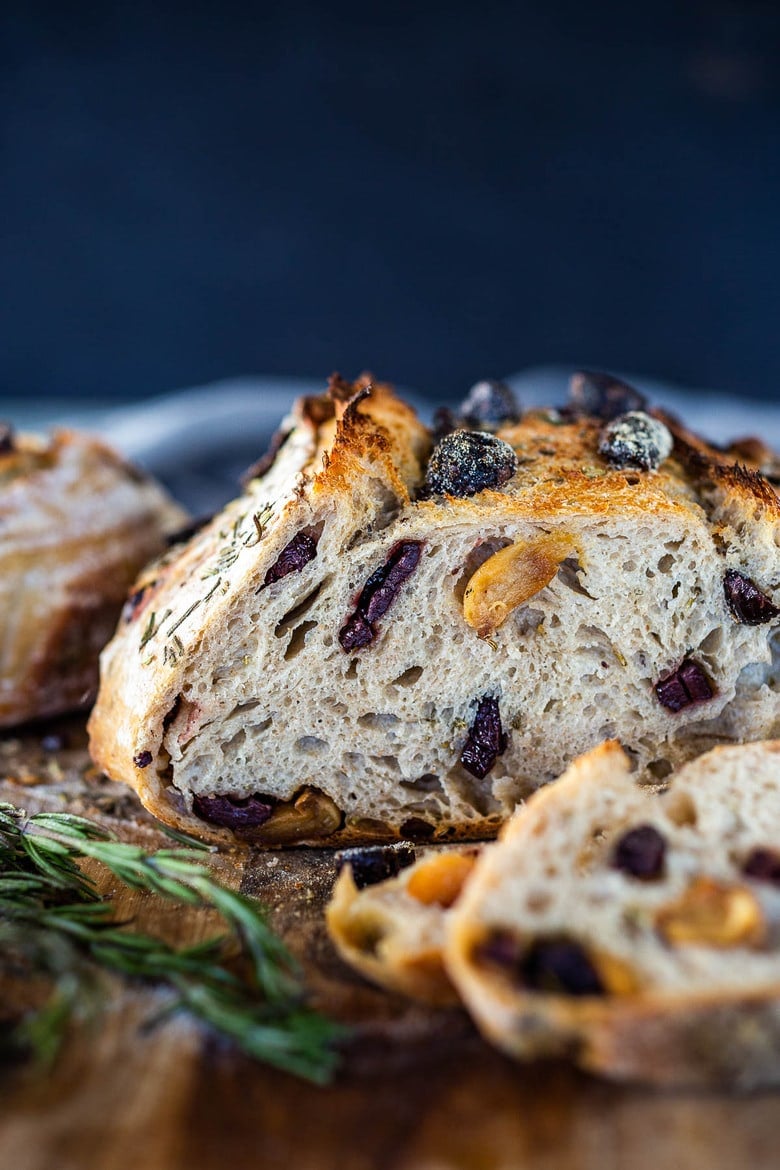
Many of you have been asking how to incorporate other ingredients into your sourdough bread recipe, so I just wanted to share one variation we’ve been making at home- Rosemary Olive Sourdough Bread with roasted garlic cloves.
This is my husband’s “dream loaf” and so it is one that is on repeat around here.
Before I start, I want to stress that this recipe is for those who have mastered our Easy Sourdough Bread Recipe. So start there first and then come back here. OK? 😉 It is very similar to that process, up until after the long overnight rise. Then we changed it up a bit.
What you’ll need:
- Sourdough Starter -make sure your starter is active and bubbly and doubles within 6 hours of feeding!
- Bread flour
- Salt
- Kalamata Olives
- Rosemary
- Roasted Garlic
- A Dutch Oven– Here are the 3 Best Dutch Ovens for Bread Baking
How to make Rosemary Olive Sourdough Bread (instructions)
Step 1. Mix the flour and salt in a bowl. (See the recipe card for detailed measurements.)
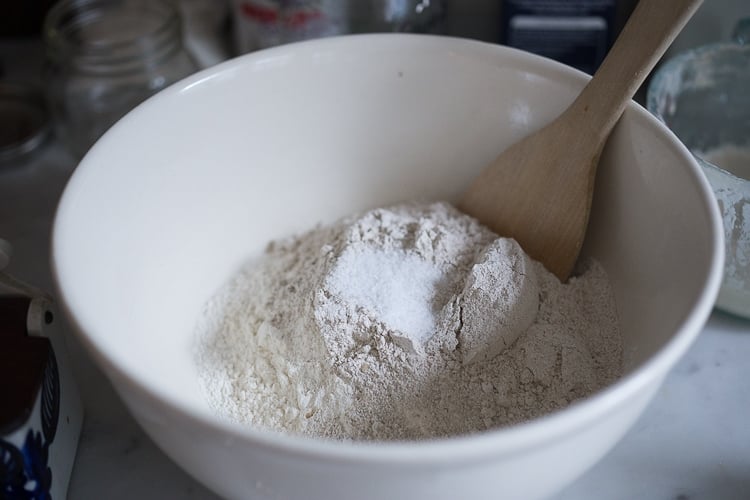
Step 2. Mix the water and starter in another container.
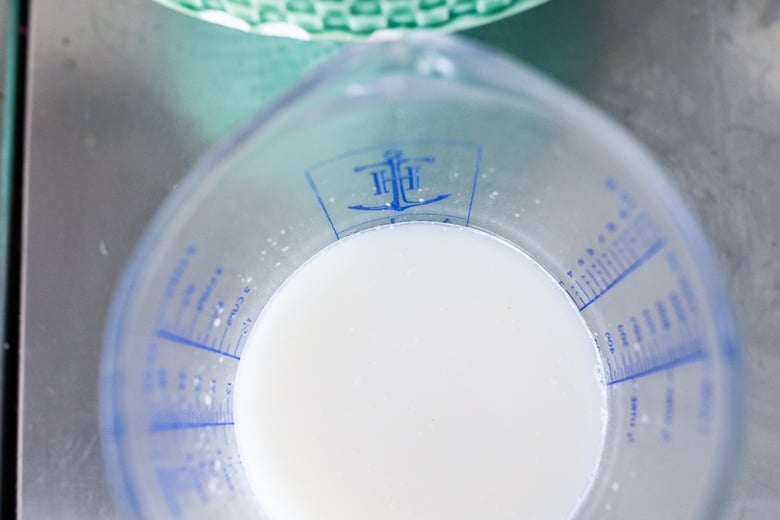
Step 3: Pour the water/starter mixture into the flour bowl and mix to incorporate, until all the flour is combined. If your mixture is very dry, it is OK to add a little bit of water so all th flour is incorporated. Cover the bowl with a damp kitchen towel.
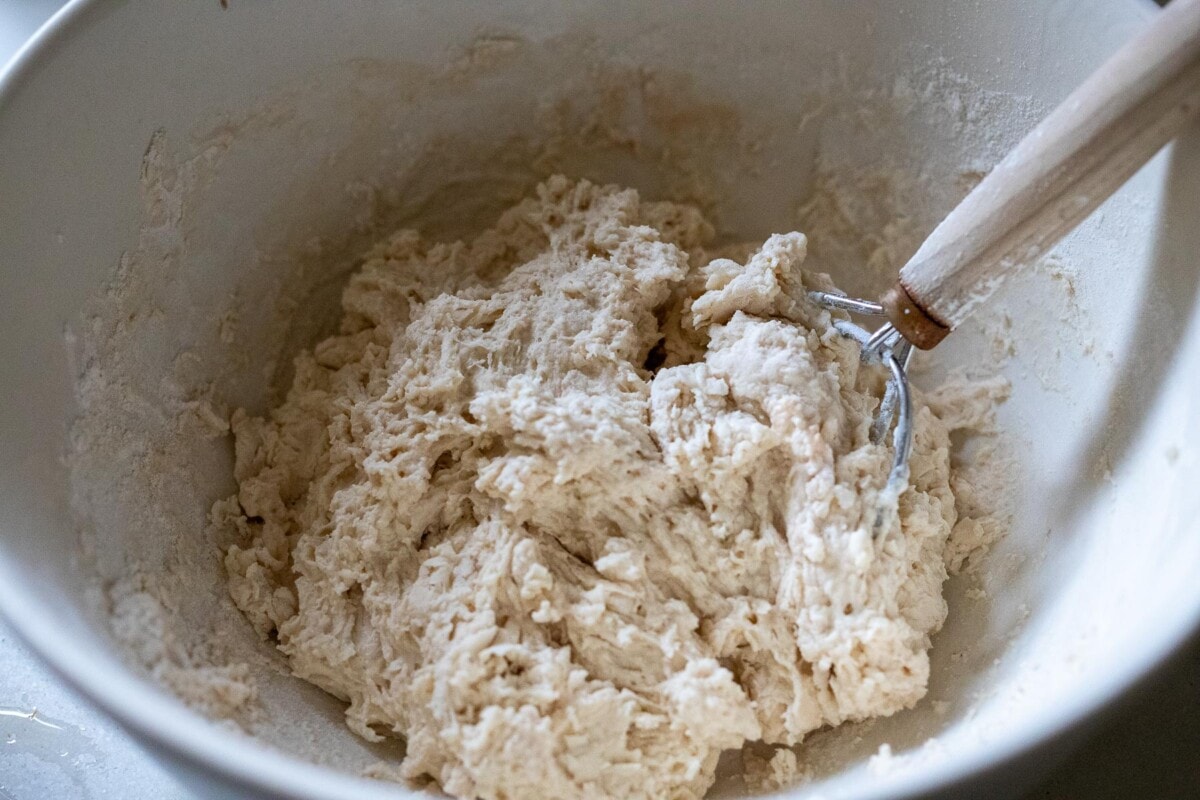
Step 4. Wait 15 minutes and then do two sets of “stretch and folds”, 15 minutes apart. You already know how to do this, but here is a refresher.
Sourdough bread “Stretch and Fold” Technique: | 45-sec Video
Step 5. Cover with a damp towel and let the dough rise overnight on the counter.
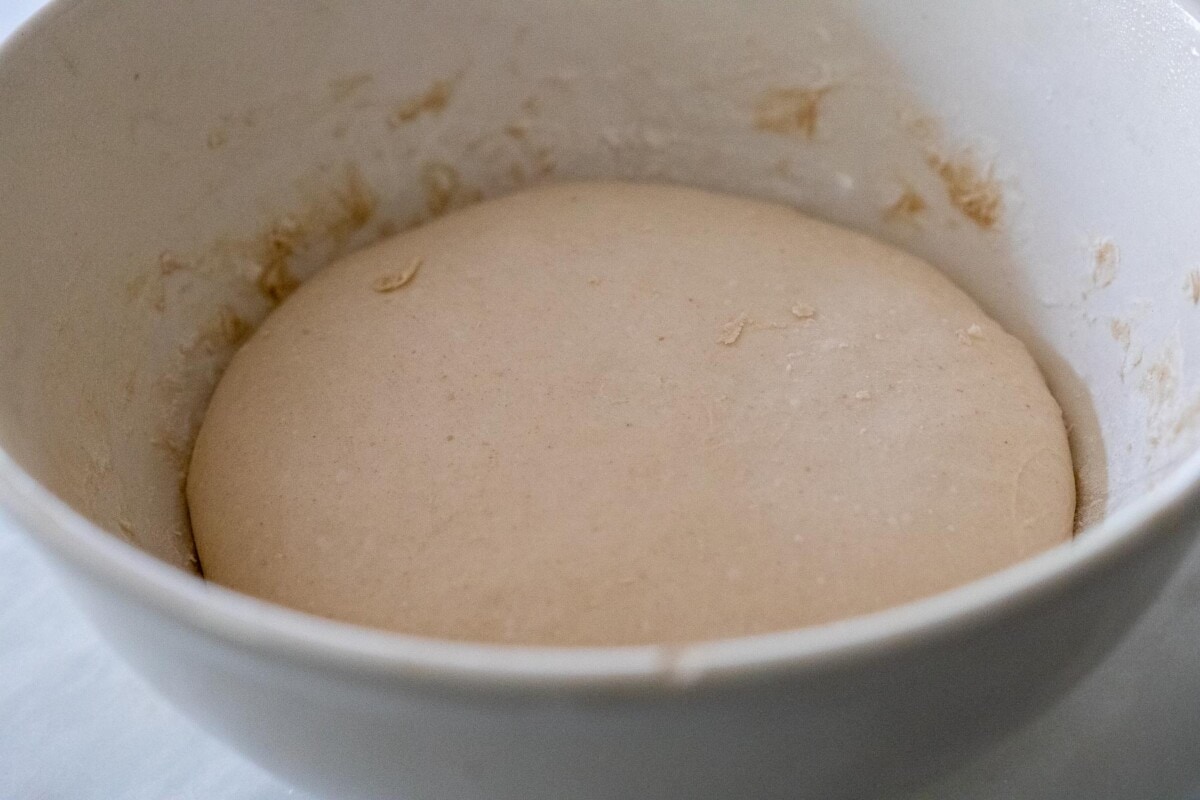
In the morning, the dough will have swollen, and jiggle like a full belly.
Step 6. When you think the dough has risen sufficiently, scrape the sides with a dough scraper (or wet fingers) and gently pour onto a well-floured surface. Gently pat into a rectangle, roungly 9 x 13.
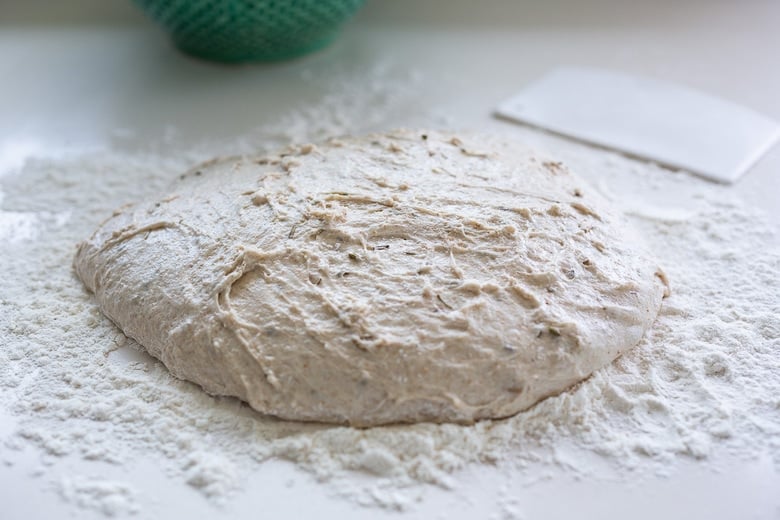
Step 7. Sprinkle in the ingredients you want to add. Here I’m using kalamata olives, roasted garlic and rosemary.
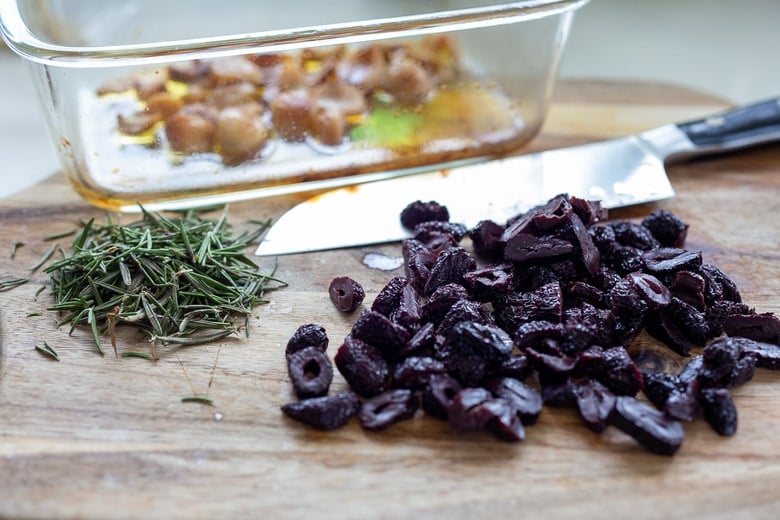
The roasted garlic adds so much flavor!
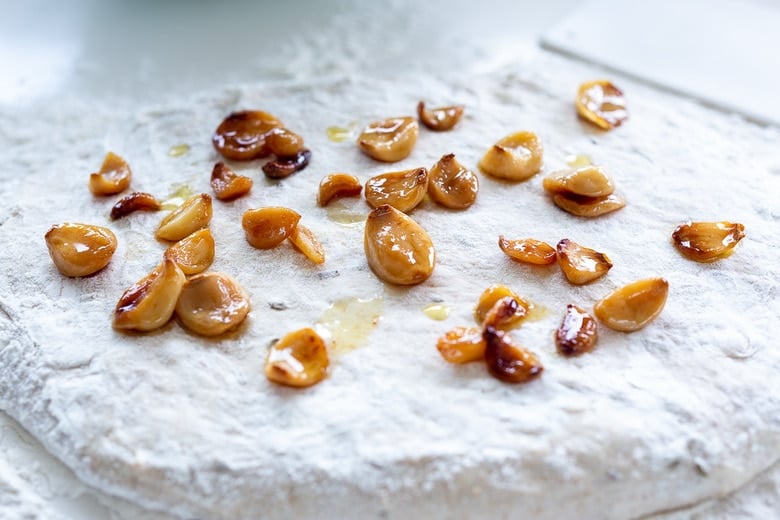
I really love this combo!
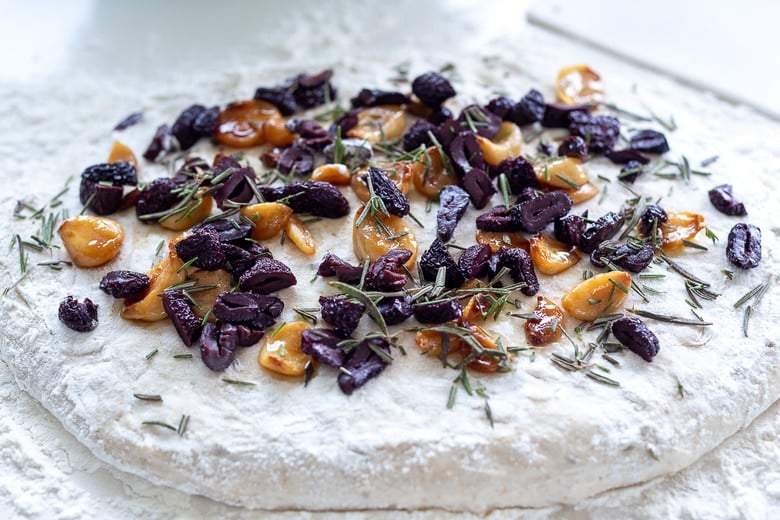
Step 8. Using a dough scraper lift one side up and over like a trifold letter. You can also simply roll up the loaf into a log if that feels easier.
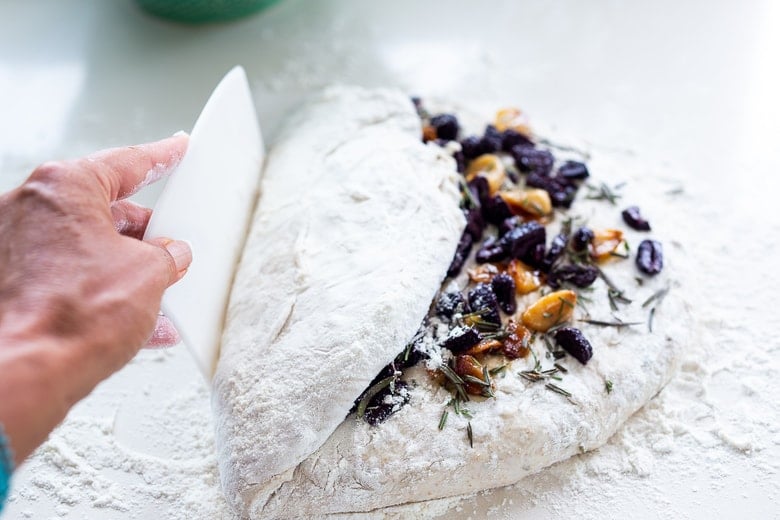
Tip: If doing the trifold, lift the other side, being mindful to overlap, so the dough is in between the filling, so the filling gets spread out in the final baked bread. Let this rest 15 minutes.
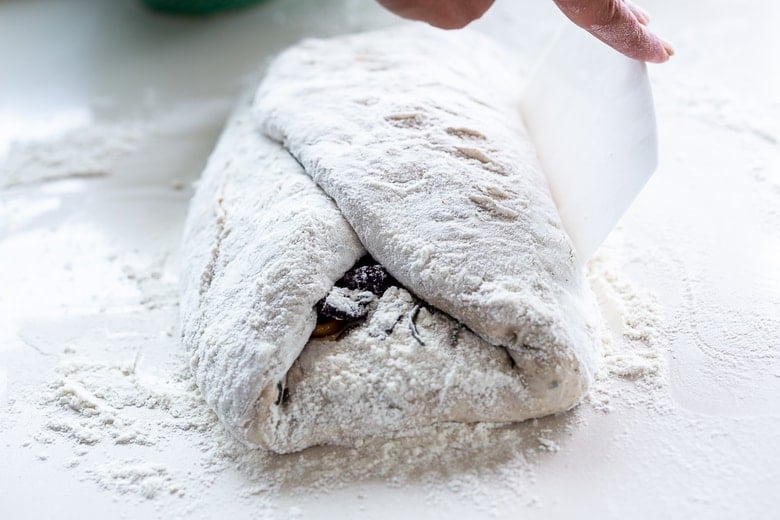
Step 9: Then repeat, turning the dough horizontally, gently flattening it out again, just a little, and tri-folding it once more, in the opposite direction. (Alternatively if you have rolled the dough into a log, turn it seam side down and fold under the ends to match the size of the banneton.)
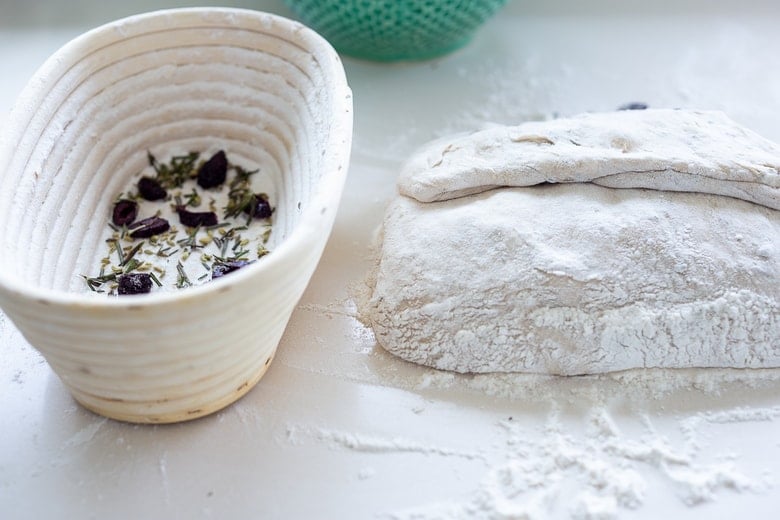
Step 10: Lift it into a well-floured banneton ( rice flour is best). You can sprinkle the banneton with more olives and herbs to decorate the top of the loaf. Be sure it is seam side up, pinching any seams closed. If you don’t have a banneton, use a parchment-lined bowl sprayed with a little olive oil.
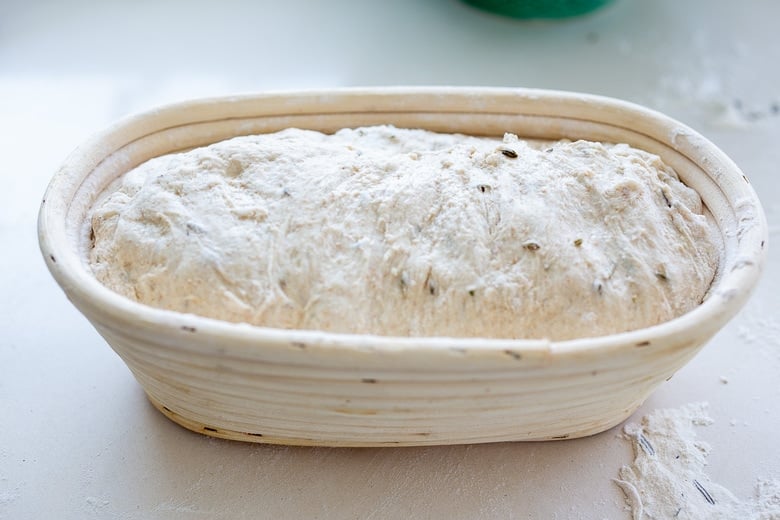
Step 11. Refrigerate for one hour while you preheat the oven with your lidded Dutch oven inside.
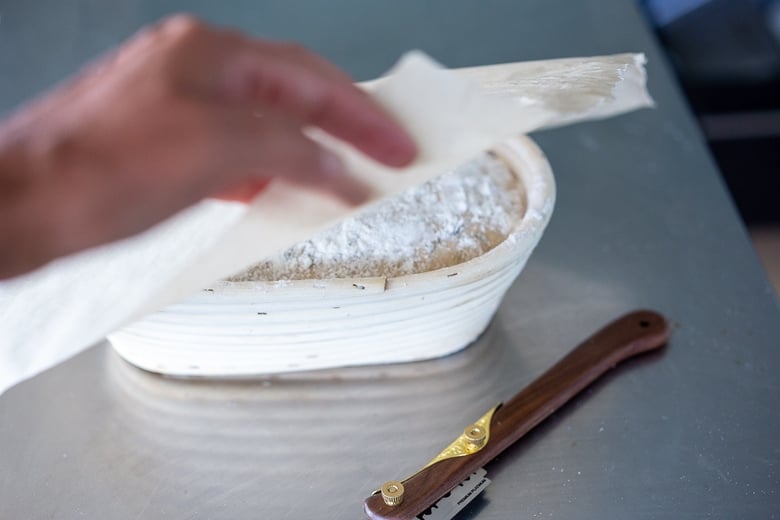
Step 12: When ready to bake, here is an easy way to get the dough into the dutch oven. Cover the dough with parchment and flip it onto the counter.
Alternatively, if you are an experienced baker, feel free to flip the sourdough directly into the dutch oven, you actually don’t “need” the parchment, we only use it here to make the dough easier to center.
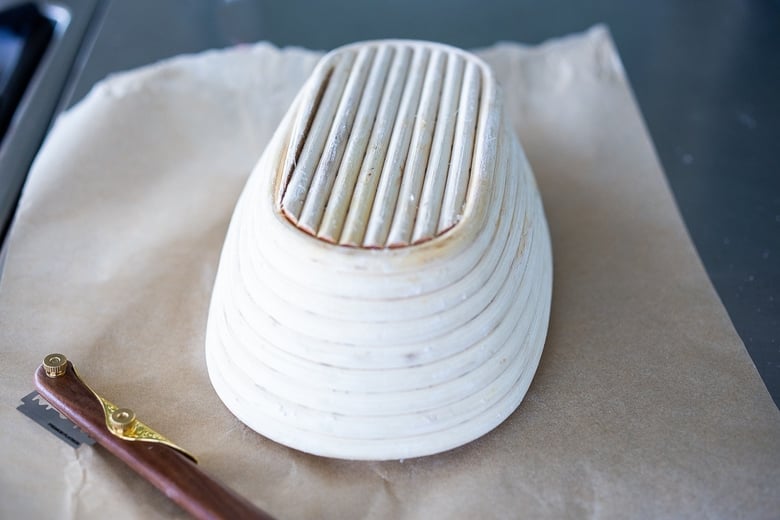
Step 13: Score using a razor or lame, then lift the dough and parchment into the dutch oven and bake!
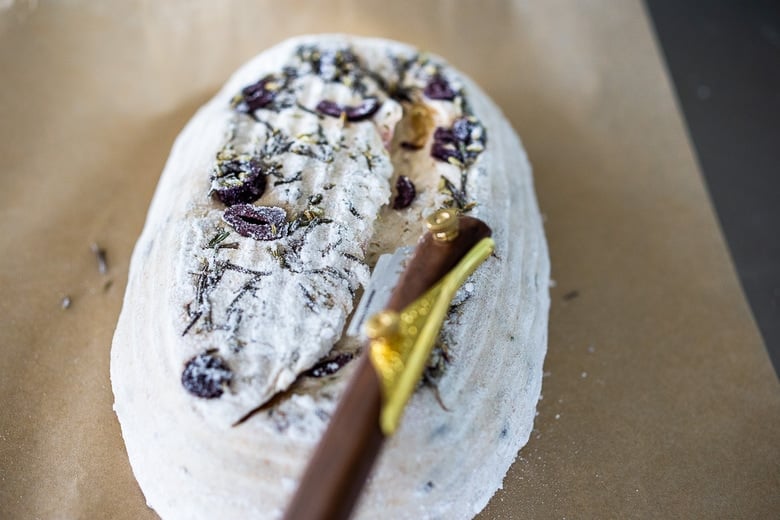
Here I’m using a lame to score the bread. It makes it very easy. If you’ve been baking a while, and plan on doing it more. Now is the time to treat yourself to a lame. It makes scoring fun! Also, consider getting a Banneton.
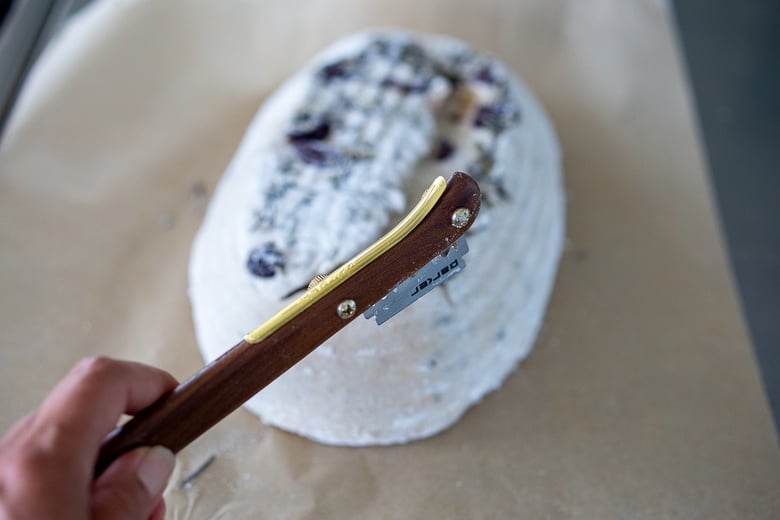
Step 14: Bake the bread in a 500F oven, covered, for 20 minutes, remove the lid and check the bread temp -internal bread temp should be around 200F. Continue baking uncovered 5-10 more minutes until deeply golden and internal temp reaches 204-208F.
If when you remove the lid, and the dough is has not yet reached 200F, replace the lid for a few more minutes, to let it get up to 200F before uncovering.
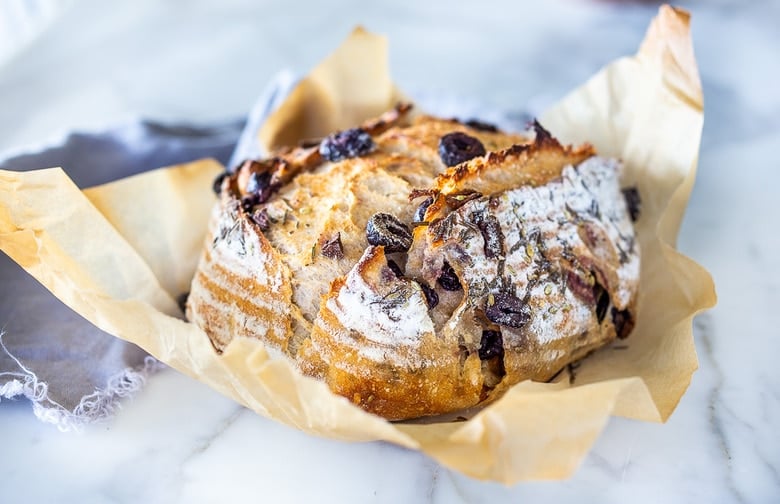
Serving suggestion
Let the bread rest 1 hour before cutting into it. Enjoy! I love this bread toasted, and served with good olive oil and balsamic for dipping.
Storage
Wrap in a kitchen towel or paper bag, or use a large zip lock. Store on the counter for 4-5 days, or in the fridge for 10 days. Or slice and freeze.
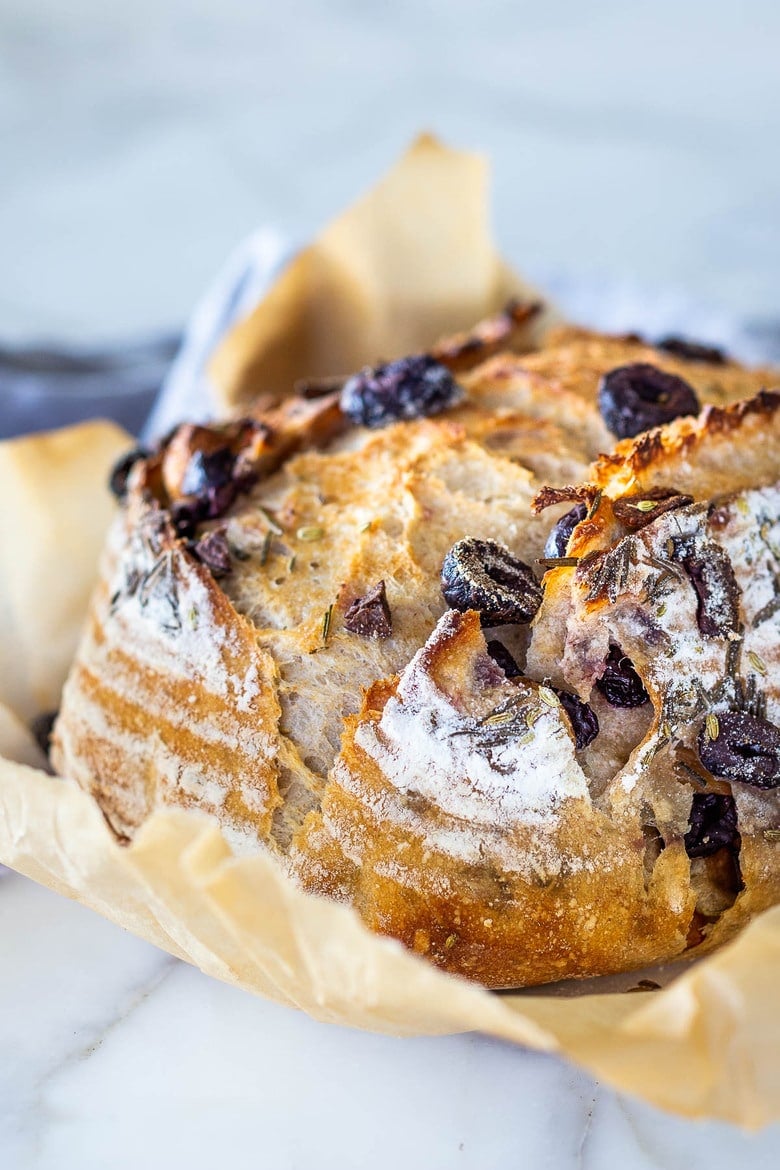
More Favorite Bread Recipes
- Vegan Banana Bread
- Overnight Sourdough Waffles
- Sourdough Pancakes
- Sourdough Scones
- Sourdough Biscuits
- Sourdough Buns
- Sourdough croutons
- The 3 Best Dutch Ovens for Bread Baking
On the homefront: The leaves begin their gradual turning and the sun sinks down a little lower in the horizon, creating the beautiful light I’ve come to love about the Northwest in the fall.
This week has been all about cozy slippers, making soup and baking bread. Truthfully, I’ve had some failures in the bread department. I won’t go into the nitty-gritty, but I am reminded that even if you’ve made bread hundreds of times, you still must pay attention.
Like life, there are endless possibilities for learning and the moment we think we’ve mastered it, life comes along and shows us otherwise. Ha!
Perhaps being human means that each day I have the opportunity to learn. And forgiving myself when I fail.
Have a beautiful fall weekend and happy baking.
xoxo
Be sure to show me your sourdough bread creations! I’m sure you’ll come up with lots of variations and I can t wait to see them! Show me on Instagram tagging #feastingathome.
Watch How to make Rosemary Sourdough bread!
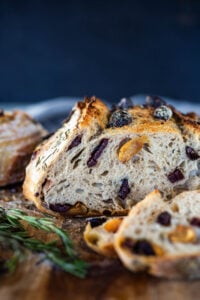
Rosemary Olive Sourdough Bread
- Prep Time: 25 mins
- Cook Time: 40 mins
- Total Time: 1 hour 5 minutes
- Yield: 1 loaf
- Category: bread, sourdough recipes,
- Method: baked
- Cuisine: northwest
- Diet: Vegan
Description
How to make Crusty Sourdough Bread, infused with rosemary, roasted garlic and olives that requires no kneading and rises overnight. Made with sourdough starter instead of yeast! Allow 10-14 hours rising time!
Ingredients
Basic Overnight Sourdough Bread
- 4 cups organic white bread flour (520 grams) see notes
- 2 teaspoons sea salt (12 grams)
- 1/3 cup sourdough starter (use after it has peaked) 90 grams
- 1 7/8 cup water (385 grams)
—–
- 3/4 cup chopped kalamata olives
- 2–3 tablespoons fresh rosemary, chopped
- 1/2 cup roasted whole garlic cloves (optional but good)
- rice flour for dusting (or sub regular flour)
Instructions
- Read through and perfect the No-Knead Sourdough Recipe (watch the video there) I recommend not attempting this until you have mastered that recipe. 🙂
- Mix the dough: At night, in a large bowl, mix flour and salt together. In a small bowl, mix starter and water together using a fork. Pour the starter-water into the flour mixture and stir with a fork until relatively combined. Using a wooden spoon, or dough mixer, scrape sides and mix dough for one minute, incorporating all the flour. The dough will feel thick and heavy and shaggy. Just do your best to incorporate all the flour. If for some reason the dough will not incorporate all the flour, add a tablespoon of water at a time to get it incorporated. Cover with a damp kitchen cloth, wait 15 minutes and do 2 sets of stretch and folds, 15 minutes apart. See video.
- RISE: Let rise overnight on the counter 10-14 hours. 65F-70F is ideal. In the morning, the dough should have swelled, but not quite doubled. Do the poke test.
- Prepare your banneton dusting the banneton with rice flour and perhaps some olives and rosemary in the bottom ( which will end up being the top.) See notes for using a regular bowl.
- SHAPE: Using a wet dough scraper, or wet fingers, loosen the dough around the edges and pour it onto a well-floured surface. Treat the dough gently, flattening lightly with your fingertips into a rough rectangle about 1 1/2 inches thick. It need not be perfect. Sprinkle the olives, rosemary and garlic over the surface. Using the dough scraper, lift up one side, stretching just a bit up and over to the middle, then fold up the other side, like a tri-fold envelope. You want the dough to be inbetween the filling so all the filling is not in one area. (See notes) Turn the dough horizontally. Let the dough rest for 10 minutes. Then repeat. Gently flatten with fingertips (it needn’t be as flat as the first time), then do another tri-fold. Pinch the seams closed and lift into the prepared banneton, seam side up.
- REST & PREHEAT Place dough in the fridge uncovered for 1 hour, while you preheat the oven to 500F (or 475F) with your lidded dutch oven inside.
- SCORE: Pull the dough from the fridge and have your lame (or sharp knife or razor blade) ready to score. Place a piece of parchment over the banneton and flip the dough, setting down on the counter over the parchment. Score 3/4 -1 inch deep at a 45-degree angle- basically wherever you want the dough to puff up. One slash is fine, or create a design.
- Pull the Dutch oven oven from the oven and close the oven door. Remove the lid, place the scored dough into the Dutch oven, lifting it by the corners of the parchment. (See notes) Quickly cover and place back in the oven.
- BAKE: Place in the middle of the oven for 20 mins with convection on, (or 25 minutes w/no convection ) or 28 minutes at 450F. Remove the lid, and the interior should reach 200F ( if not replace the lid until it does). Once 200F, uncover the bread, lower heat to 450F, and continue baking 10-15 minutes until deeply golden and internal temp reaches 204- 208F. No pale loaves please, let them get golden!
- COOL: Remove from the dutch oven, let it cool 1 hour on a rack or tilted up on its side, before slicing so you don’t let the steam out and don’t smash it- be patient. This is the hardest part. 😉. Take a picture! Feel proud. You did it!
Notes
NO Banneton: Use a parchment-lined bowl, sprayed with spray oil. Place dough seam side down. Sprinkle with flour and some sliced olives or rosemary if you like. Or even something like Everything Spice would be good here.
FLOUR: Feel free to sub 1/2 cup of the white flour with rye, whole wheat or other whole grain. Using more may create a heavy loaf.
Shaping: Instead of doing a tri-fold, simply roll into a log. Place seam side down on the counter and tuck the ends under. Let rest 5 minutes, before lifting into the banneton, seam side UP.
Nutrition
- Serving Size: 1 slice
- Calories: 199
- Sugar: 0.3 g
- Sodium: 541.5 mg
- Fat: 2.4 g
- Saturated Fat: 0.4 g
- Carbohydrates: 40.5 g
- Fiber: 6.1 g
- Protein: 7.4 g
- Cholesterol: 0 mg
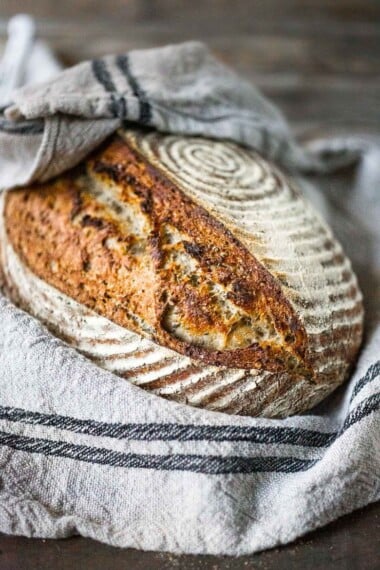

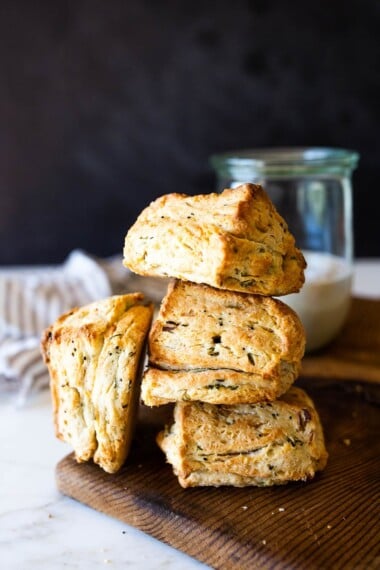
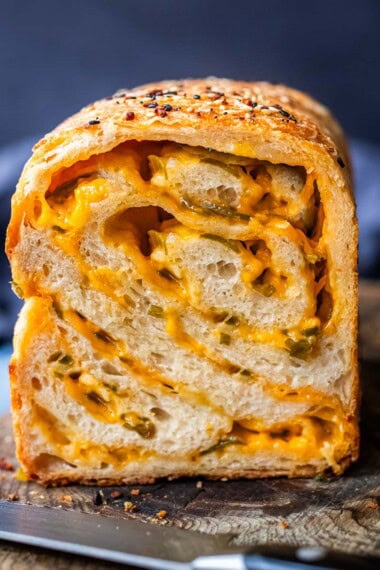
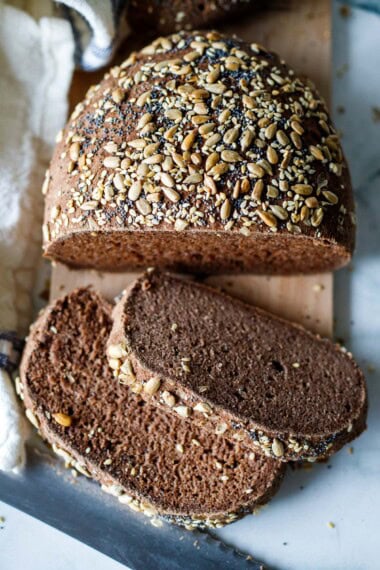
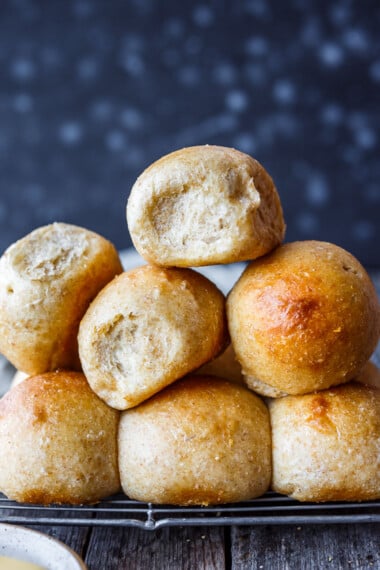





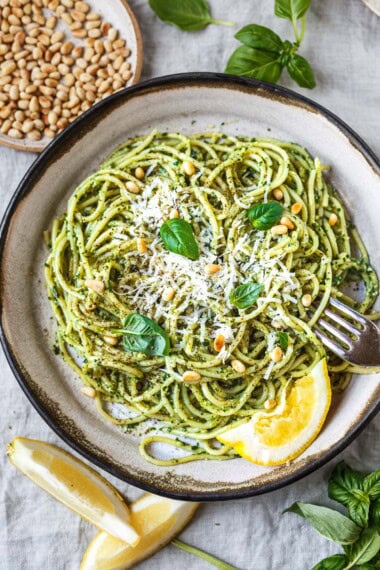
Can I pause the rise by putting the dough in the refrigerator? If yes, for how long? I need to travel for the holidays, and our nearest family is four hrs. away. I can keep it refrigerated.
Yes, you can pause and refrigerate it for 4 hours. You could also try slightly under proofing (like by an hour) it for the first rise?
This looks amazing, I’m currently making an olive loaf but I’m definitely going to try this, who can resist roasted garlic?
Let us know how it goes!
How do you measure the internal temp of your loaf of bread?
Love this recipe and use it often, but no idea how to do this.
An instant read thermometer is the best and most accurate way to test. You can use on any baked goods, it is so useful in helping to achieve the perfect texture!
I used 2 loaf pans instead of a Dutch oven and it worked great!
Perfect Juilanna!
Thanks for the recipe. Would it work in a sandwich pan instead of in a banneton? I don’t have dutch oven or banneton. Would the baking instructions remain the same?
Hi Jagadeesh- you could try that- I would bake lower, longer, perhaps tenting with foil if it gets too dark. I would Bake at 450 for 15 minutes, then lower heat to 400F until internal temp reaches 204F
No fuss receipe, the best I tried as I experimented around. The bread came out super and it tastes so delicious with the roasted garlic. Thanks for sharing the receipe. 🍞🫒💖
Awesome to hear Kirsten- thanks for circling back and rating it!
So Easy – Turned out amazing! My Friends Loved it. Just made it again.
Great to hear Sandy!
I just started making sourdough bread and this ended up perfect! I have now used the same techniques to add different inclusions, such as cubed sharp cheddar and sliced jalapeńo. Amazing!!
Oh great to hear Ragna!
I am also a new sourdougher and experimented with different receipes. This is by far the best and it’s fuss free. Mix the ingredients, forget about it overnight, bake after getting up in the morning and treat your family to a wonderful brunch. I will try to add cheese also as I stuck to herbs, olives and roasted garlic. Well, I am hooked on sourdough bread baking now lol
Thanks so much Kirsten! Glad this worked well for you!
Delish!
Can’t even believe how perfectly my first attempt came out! I tried a 2nd loaf with olives, thyme, and lemon zest- so good! Any tips on how to make a gruyere cheese loaf or on adding cheeses in general. I am so pleased with the loaf itself and I’m ready to try the recipe with a few different flavors.
So happy you enjoyed it! I would just add cheese like you do th olives in this recipe.
Here’s my take: you tell us to perfect the No-Knead Sourdough Recipe, then you basically copied and pasted that recipe we’re supposed to have mastered. I wish you had put more into Step 5, the key step that differentiated this recipe. Because I did what I thought you meant when you said “Sprinkle the olives, rosemary and garlic over the surface,” which was to use ALL of the olives, rosemary and garlic on the first rectangle of dough, prior to the first trifold.
The result was clumps of olives and garlic in different areas, but alll just beneath the crust… nothing in the middle. And awkward to cut because the clumps keep falling out.
Now I’m wondering if you meant put HALF of the olives, rosemary and garlic prior to the first trifold, and then with “Repeat” we were to have put the other half on prior to the second trifold.
Or do I have that wrong and there’s a different explanation for this loaf fail?
Hi Gregor, I appreciate your feedback and understand what you are saying. We recently added a video, maybe that will help? You can also just roll the dough into a log and fold the ends under if that is easier. I do it that way too espeically if i have a lot of filling. You could do half ( like you said) then fold and do another half of filling too. I ususally just put it all in one layer and when I fold it up, I make sure there dough inbetween. I see how that would be tricky. Try rolling it next time?
This was amazingly perfect.
Thanks Ragna!
This reminds of my fav focaccia. Would it work to add a bit of feta and caramelized onions? Would any changes be needed in the hydration or dough for it to bake properly?
That sounds tasty Diego, feel free to add, and no modifications needed!
1st time making sourdough and decided to go all the way and make the Rosemary/Garlic Olive Bread. Delicious! Not sure it rose as much as I wanted when I took it out of Dutch Oven but still very good.
Great to hear Gino! Love your ambition!
Great beginner guide! I’ve been struggling with how to make good bread for a while. Moisture is key for getting a nice crumb/lighter loaf. 🙏
Thanks Alexander, glad you liked this!
I’m baking a walnut cranberry in a loaf pan in a non convection oven at 450° for 28 min. To bake for the last 10-15min do I lower the temp or just leave at 450°? Thanks:) Love your bread! and kimchi!
Monique
I would just check the color and temp, and gage from there- goal is 204F internal temp without it getting overly brown.
Thanks Sylvia. I didn’t lower, and just watched it. It turned out perfect! Except the shape and the distribution of walnuts and cranberries. I have done this recipe a couple 3 x now and I just can’t quite figure out how to shape it so raisins or cranberries get distributed throughout. They seem to all want to congregate to the outer crust what am I doing wrong? I fold it like an envelope- and then not sure what to do after that- it says to turn horizontally but it’s already horizontal after folding like a letter..so I’m at a loss..thanks for your help!
Awww, I see how my photos can be confusing. Press the olives and garlic into the flattened dough, so they stick when you fold. The first folds are from the edges towards the middle. A tri-fold. Rotatle this vertical rectangle, to a horizontal rectangle. Flatten it a bit. Then, once more fold over the edges to the middle, one edge over the other. Shape form there. Hope that helps?
Hello Sylvia,
I have been making your rosemary olive bread for two years and the result has been great, it is a bread to impress. Now lately, however, I have had two loaves where the dough rises too much and becomes quite sticky. It has no shape anymore and it is quite difficult to form. What am I possibly doing wrong? Should I allow less fermentation time? I usually make it 10 pm and bake it in the morning. I have to mention that I moved from DC to New Orleans and the temperature/humidity is different but with the AC on, shouldnt it be the same?
Looking forward to hearing from you.
Hi Benan- It sounds like it is over proofing, so yes I would try shortening the time. I think humidity can affect the bread for sure.
I’ve been making the rosemary, olive sourdough bread for months and have had great success. Lately, however, my bread hasn’t been rising as nicely as it did in the past. I put it in my proofing oven and after a couple of hours I notice that it becomes sticky. When I attempted the poke test my fingers stuck to the dough. I refrigerated it for a few hours and then baked it, but it never rises as well as it used to. Am I under fermenting, over fermenting? Any advice you could give me is greatly appreciated.
Hey Susan, I would first make sure your starter is active and happy, maybe leave it out of the fridge for a few days, feeding as hungry. Confirm that it doubles within 6 hours of feeding.
Great recipe! Just baked my olives bread and it looks delicious! Didn’t try it yet, I’m going to wait for about an hour, but smells heavenly inside my house!
Great to hear!
I started a loaf last night without your directions. I added 1 Tbsp cinnamon to dough and it just won’t rise. Bummer. I’ll try again this evening and add the ‘extras’ after fermentation. I wonder why cinnamon did this!?!
Oh shoot Jen! I can’t imagine the cinnamon prevented the rise, but I have never tried adding it in the first proof. Let me know how it goes. 😉
Hi Sylvia,
I’m wondering if I can make a cinnamon raisin loaf with this method. Would I need to add any honey or sugar, if so, when? Should the raisins be soaked? Thanks so much. I have loved sharing my starter, your recipes, and delicious loaves with my family and friends.
Hi Jen- I do this all the time! I usually spread the rectangle with a little butter, then add 2 tablespoons of cinnamon and 3-4 tablespoons brown sugar and roll into a log and bake in a buttered loaf pan at 375F. Feel free to soak raisins or not. Diced apple is nice too.
Sooooo good. I did two loaves – cheddar jalapeño and garlic herb. They both came out fantastic! My family has been snacking on them and they’re both already halfway gone. I’ll be trying sun dried tomato basil and cinnamon raisin tomorrow! Thanks for the awesome recipe!
Thanks Alyssa!
Do you have a recipe for sourdough sandwich bread in loaf pans?
Yes, Donna go to our Overnight Sourdough Bread Recipe, scroll down to the recipe card and read the Notes. You’ll see notes on using a loaf pan. 🙂
I have been using this amazing recipe for the past year +. I’m wondering if you’ve made other versions/additions. I’d like to try jalapeño and cheese (with a little honey). I think the honey would go in at the beginning and maybe laminate the cheese and jalapeño at the end (when olives would be added). Or should I add the cheese in sooner. AndI think about 100g of additions would be right? Your advice please. 🙏🏼
Hi Jen! I’ve made jalapeno cheddar and it is so good. I would add the honey in the beginning and cheese and jalapeno at the end- just like you said first!
I made this for my friend who was visiting, sans olives per her request, but still used the roasted garlic and fresh rosemary. It turned out so well!! We ate it with your tomato soup recipe – to die for!
Love it Angeli- and perfect with that soup I bet~!